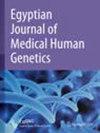Evaluation of expression levels of microRNA processing elements in patients with sudden sensorineural hearing loss
IF 1.2
Q4 GENETICS & HEREDITY
引用次数: 0
Abstract
MicroRNAs have a significant role in the function and development of the hearing system. Idiopathic sudden sensorineural hearing loss (SSNHL) is a complicated disorder with no long-established reason. Since microRNAs play imperative roles in every aspect of the neural system, their dysregulation may contribute to the onset of SSNHL. The current study aimed to assess the expression patterns of microRNA processing elements (DROSHA, DICER, and DGCR-8) as the vital factors in microRNA biology that can affect the expression levels of microRNA. This study assessed DROSHA, DICER, and DGCR-8 mRNA expression levels in the peripheral blood mononuclear cells (PBMC) of 50 patients with SSNHL and 50 matched controls. After the isolation of PBMC, total RNA was extracted, and the expression levels of DROSHA, DICER, and DGCR-8 genes were evaluated using quantitative real-time PCR. The results illustrated significant up-regulation of DICER and DGCR-8 genes in SSNHL patients at the mRNA level. Furthermore, despite no significant change in DROSHA level, DICER and DGCR-8 were significantly correlated with SSNHL. However, there was no significant correlation between these gene expressions and the clinicopathological features of patients. This study verified for the first time that the DGCR_8 and DICER mRNA expression levels were significantly up-regulated in patients with SSNHL, proposing that microRNAs and their processing pathways play key roles in the progression and development of SSNHL.评估突发性感音神经性听力损失患者体内微RNA处理元件的表达水平
微RNA在听力系统的功能和发育中起着重要作用。特发性突发性感音神经性听力损失(SSNHL)是一种复杂的疾病,长期以来没有明确的发病原因。由于 microRNA 在神经系统的各个方面都起着至关重要的作用,它们的失调可能会导致 SSNHL 的发病。本研究旨在评估 microRNA 处理元件(DROSHA、DICER 和 DGCR-8)的表达模式,它们是 microRNA 生物学中影响 microRNA 表达水平的重要因素。本研究评估了 50 名 SSNHL 患者和 50 名匹配对照者的外周血单核细胞(PBMC)中 DROSHA、DICER 和 DGCR-8 mRNA 的表达水平。分离 PBMC 后,提取总 RNA,使用实时定量 PCR 评估 DROSHA、DICER 和 DGCR-8 基因的表达水平。结果表明,在 SSNHL 患者中,DICER 和 DGCR-8 基因在 mRNA 水平上明显上调。此外,尽管 DROSHA 水平无明显变化,但 DICER 和 DGCR-8 与 SSNHL 有显著相关性。然而,这些基因的表达与患者的临床病理特征并无明显相关性。这项研究首次验证了DGCR_8和DICER mRNA表达水平在SSNHL患者中明显上调,从而提出microRNA及其处理途径在SSNHL的进展和发展中起着关键作用。
本文章由计算机程序翻译,如有差异,请以英文原文为准。
求助全文
约1分钟内获得全文
求助全文
来源期刊

Egyptian Journal of Medical Human Genetics
Medicine-Genetics (clinical)
CiteScore
2.20
自引率
7.70%
发文量
150
审稿时长
18 weeks
 求助内容:
求助内容: 应助结果提醒方式:
应助结果提醒方式:


